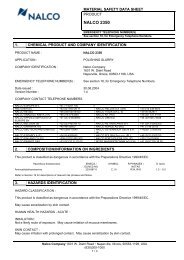Waxless Fixturing - N. Bucher AG
Waxless Fixturing - N. Bucher AG
Waxless Fixturing - N. Bucher AG
Create successful ePaper yourself
Turn your PDF publications into a flip-book with our unique Google optimized e-Paper software.
February 16, 2004<br />
page 1/2<br />
RODEL - <strong>Waxless</strong> <strong>Fixturing</strong><br />
Rodel pioneered the development of waxless mounting systems for the semiconductor market by<br />
inventing standard template assemblies and insert process template assemblies. Our template<br />
assemblies provide excellent flatness without using mounting wax.<br />
Standard Template Assemblies<br />
Compared to wax mounting, template assemblies are efficient and easy to use:<br />
Easy application - pressure sensitive adhesive on template assemblies allows easy<br />
application to carrier plates<br />
Easy removal - wafers are easily removed with a water pick or in a water bath after polishing<br />
No de-waxing clean step is required - no chemicals are used to hold the wafers<br />
No CFC's - template assemblies are environmentally friendly and non-hazardous<br />
Standard template assemblies are composed of the backing materials on which the wafer rests and<br />
the template, which holds the wafer in the place. The FR4 template additionally provides a rigid<br />
support structure around the wafers during polishing.<br />
Insert process Template Assemblies<br />
Insert process template assemblies are composed of the mounting material and support structure.<br />
Unlike the template assembly, these two parts are physically separate entities. The support structure<br />
consists of urethane recesses attached to a urethane backing plate. Inserts of mounting material are<br />
precision die-cut to fit in the recesses before the wafers are put into place.<br />
The assemblies are cost effective because the inserts - the surface the wafer contacts - are easily<br />
renewable while the support structure can remain on the carrier for numerous changes. Insert process<br />
template assemblies offer the following advantages over standard template assemblies.<br />
Improved flatness - over many runs, the inserted mounting material can easily be changed.<br />
Greater economy - the more durable portion of the fixture, the template itself, need not to be<br />
replaced when the mounting material is worn or fatigued.<br />
Greater efficiency - less operator time and effort are needed to replace an insert than to<br />
change standard template assemblies<br />
Template Assembly Parameters<br />
Parameter<br />
Template Assembly<br />
Insert Process Template<br />
Assembly<br />
Recess Shape Many possibilities Round circles standard<br />
Recess Size Many possibilities Standardized for 2" Through 6" wafers<br />
Recess Depth .005" to .024" standard, custom on request Many possibilities<br />
Corresponds to diameter of users carrier Corresponds to diameter of users carrier<br />
Outer Diameter<br />
plate<br />
plate<br />
Mounting Material DF200, WB20 & 40USD standard DF200 is standard for inserts<br />
Support Material FR4 JR111<br />
Materials for Wafer Mounting Assemblies<br />
Mounting Materials for standard template assemblies can be made from either buffed or unbuffed<br />
poromeric materials.<br />
Buffed surfaces - With buffed surfaces, the wafer "floats" on the mounting material and rotates in the<br />
pocket during polishing. This action minimizes localized surface irregularities on the polished wafer<br />
and yields the flattest wafers.
February 16, 2004<br />
page 2/2<br />
RODEL - <strong>Waxless</strong> <strong>Fixturing</strong><br />
Unbuffed surfaces - Unbuffed surfaces provide more secure mount through suction forces in the<br />
sponge-like structure of the mounting material. The resulting sealing action helps to protect the<br />
backside of the wafer. Some unbuffed materials can be used to mount irregularly shaped wafers<br />
without a template surround.<br />
How to use Wafer Mounting Assemblies<br />
Mounting the Assembly to the carrier:<br />
<br />
<br />
<br />
<br />
<br />
Peel back 1/5 of the release paper<br />
Line up assembly with clean carrier<br />
Press down thoroughly to exclude trapped air<br />
Remove remainder of release paper and press recess to exclude air bubbles<br />
Run hand outward to all sides insuring total adhesion to the carrier<br />
Mounting the Wafer to the Template Assembly:<br />
Standard Template Assembly<br />
<br />
<br />
<br />
<br />
Before first use, check pockets for trapped air under PSA. A slight razor cut and hand<br />
pressure should release it.<br />
Saturate assembly backing pad with DI water<br />
Scrub pockets with a soft nylon bristle brush and then rinse with DI water again<br />
Place wafers on assembly and wring onto the backing pad<br />
Insert Process Template Assembly<br />
<br />
<br />
<br />
<br />
Thoroughly wet both sides if inserts<br />
Place wet insert into pocket of template assembly<br />
Press wafer onto insert<br />
Scrub insert with a soft nylon bristle brush and then rinse with DI water<br />
Standard Template Assemblies<br />
Insert Process Template Assemblies<br />
Manufacturer: Rodel, Inc.<br />
Supplier: N. BUCHER <strong>AG</strong>, Pfadackerstrasse 9, 8957 Spreitenbach/Switzerland<br />
Phone: ++41-56 418 19 90<br />
Fax: ++41-56 418 19 99<br />
mailto:info@nbucherag.com<br />
REV. 04/01

















